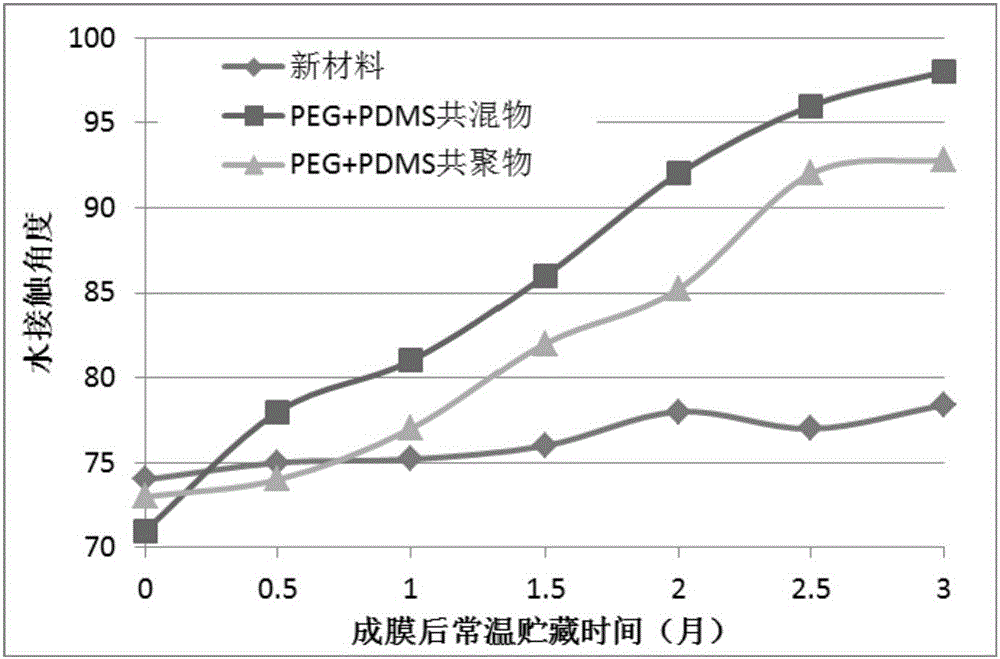Triblock copolymer with high biocompatibility and preparation method and application thereof
A biocompatible, tri-block technology, applied in applications, medical science, sensors, etc., can solve problems such as poor controllability of permeation and diffusion, poor water and heat resistance, unfavorable production and long-term storage, and achieve difficult-to-film surface properties Change, hydrolysis resistance, good heat resistance, good heat resistance and stability
- Summary
- Abstract
- Description
- Claims
- Application Information
AI Technical Summary
Problems solved by technology
Method used
Image
Examples
preparation example Construction
[0030] The preparation method of the above-mentioned highly biocompatible tri-block copolymer comprises the following steps:
[0031] Step 1. Add highly hydrophilic soft segment materials, rigid and highly hydrophobic hard segment materials, and flexible polymers into organic solvents, and mix them uniformly at 30-45°C; organic solvents include tetrahydrofuran or isobutanol , the volume of the organic solvent and the total mass ratio of the highly hydrophilic soft segment material, the rigid and highly hydrophobic hard segment material, and the flexible polymer are 2-10ml:1g.
[0032] Step 2: Add a catalyst to the mixed solution in Step 1, and add a block chain extender dropwise, raise the temperature to 55-70° C., and react for 12-20 hours; the catalyst includes triethylenediamine or dibutyltin diisooctoate.
[0033] Step 3, add deionized water to the reaction solution in step 2, and react for 12h-18h; the volume of deionized water and the total mass of the soft segment mater...
Embodiment 1
[0037] Raw materials: polyetheramine, number average molecular weight 1000, mass 25g; polycarbonate diol, number average molecular weight 5000, mass 10g; diamino-terminated polydimethylsiloxane, number average molecular weight 5000, mass 15g; tetrahydrofuran, 100ml; diphenylmethane diisocyanate, mass 12g; deionized water 50ml.
[0038] Step 1: Add polyetheramine, polycarbonate diol, and diamino-terminated polydimethylsiloxane into tetrahydrofuran, and mix well at 40°C.
[0039] Step 2: Add triethylenediamine to the mixed solution in Step 1, and add diphenylmethane diisocyanate dropwise, raise the temperature to 65° C., and react for 12 hours.
[0040] Step 3, adding deionized water to the reaction solution in Step 2, and reacting for 12 hours.
[0041]Step 4: After cooling, the reaction product is washed, filtered and dried to obtain the tri-block copolymer.
Embodiment 2
[0043] Raw materials: amino-terminated polyethylene glycol, number average molecular weight 2000, mass 20g; polycarbonate diol, number average molecular weight 2000, mass 15g; polymethyl methacrylate, number average molecular weight 2000, mass 15g Diamino-terminated polydimethylsiloxane, number average molecular weight 8000, quality 15g; tetrahydrofuran, 500ml; 3g diphenylmethane diisocyanate and 9g dicyclohexylmethane diisocyanate; deionized water 500ml.
[0044] Step 1. Add amino-terminated polyethylene glycol, polycarbonate diol, polymethyl methacrylate, and diamino-terminated polydimethylsiloxane into tetrahydrofuran, and mix well at 30°C.
[0045] Step 2: Add triethylenediamine to the mixed solution in Step 1, and add the mixed solution of diphenylmethane diisocyanate and dicyclohexylmethane diisocyanate dropwise, raise the temperature to 55° C., and react for 14 hours.
[0046] Step 3, adding deionized water to the reaction solution in Step 2, and reacting for 18 hours. ...
PUM
 Login to View More
Login to View More Abstract
Description
Claims
Application Information
 Login to View More
Login to View More - R&D
- Intellectual Property
- Life Sciences
- Materials
- Tech Scout
- Unparalleled Data Quality
- Higher Quality Content
- 60% Fewer Hallucinations
Browse by: Latest US Patents, China's latest patents, Technical Efficacy Thesaurus, Application Domain, Technology Topic, Popular Technical Reports.
© 2025 PatSnap. All rights reserved.Legal|Privacy policy|Modern Slavery Act Transparency Statement|Sitemap|About US| Contact US: help@patsnap.com



